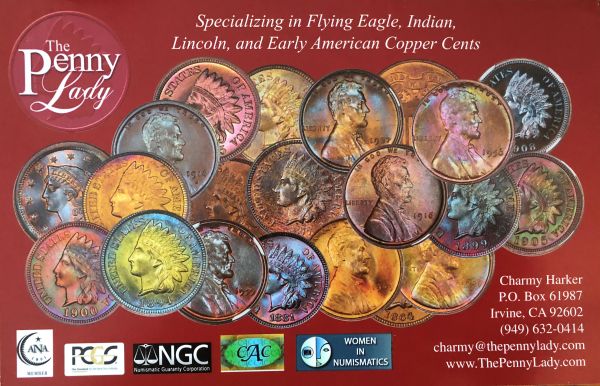
PREV ARTICLE
NEXT ARTICLE
FULL ISSUE
PREV FULL ISSUE
HENRY CLAY EZEKIEL (1846-1930)E-Sylum Feature Writer and American Numismatic Biographies author Pete Smith submitted this article on Cincinnati collector Henry Clay Ezekiel. Thanks! -Editor
Henry Clay Ezekiel (1846-1930)
I recently wrote about Peter Mougey of Cincinnati. While doing research on him, I came across an article in The Cincinnati Inquirer of June 4, 1911, which mentioned another local collector:
The collector continued the narrative,
In another part of the article was stated, Ezekiel was born in Richmond, Virginia, on January 30, 1846, the son of Jacob Ezekiel (1812-1899) and Catherine DeCastro Ezekiel (1818-1891). He served with the Confederate Army during the Civil War as a guard for Union prisoners. Ezekiel began to collect coins at age 13. He claimed that he was in the office of Richmond banker Edward Cohen around 1860 when a negro came in and sold a lot of silver coins that included an 1804 dollar. He moved to Cincinnati in 1870 and worked in the auction and commission business. He was the president of the Ezekiel and Bernheim Company conducting sales of art, books and rugs for more than fifty years. Each year he conducted an auction for choice seats at the Cincinnati Symphony Orchestra. H. C. Ezekiel placed an ad in the June 1904 issue of The Numismatist before he was listed as an ANA member. He was looking to buy all kinds of early Cincinnati money. In the issue of April 1905, he placed an ad looking for various priced auction catalogs.
He joined the ANA in 1905 as member 724. For the July 1911 issue of The Numismatist
(24:236), he submitted an article on
He wrote In the April 1918 issue of The Numismatist, Ezekiel offered the coin cabinet of Peter Mougey for sale. Ezekiel specialized in the study of early money in Cincinnati from the foundation of the city in 1788 through the end of the Civil War. The June 4, 1911, article in the Cincinnati Inquirer described this money in some details. This was an unusually long article on numismatics in a local paper. In the early days trade was done through barter. Montroville Dickeson believed that coal disks found in mounds near Cincinnati were used as currency. It was Dickeson's habit to think any disk found in a mound was used as currency. The first bank in Cincinnati, The Miami Exporting Company, was founded in 1803. That bank failed in 1842. Ezekiel studied the history of early banking and collected the banknotes. During the Civil War, many banks and local businesses printed currency for use in trade. One Cincinnati lithographer also produced counterfeits of Confederate currency to pass across the Ohio river in the South. Ezekiel published a list of counterfeit detectors and bank note reporters published in Cincinnati during 1841 to 1863. Gold coins were struck in 1849 for the Cincinnati Mining and Trading Company. The name reflects the ownership group and not the source of the gold, which was in California. Ezekiel advertised that he wished to purchase specimens but without success.
Cincinnati collector H. A. Ratterman assembled a collection of Ezekiel knew John Stanton, a prolific issuer of Civil War tokens, and wrote about him while he was still living at age 82. Stanton could not remember how many he produced, but there were hundreds. Stanton also produced Sutlers' Checks. Robert Wright was a large customer for Stanton's tokens. He had a standing order for 10,000 tokens a week and bought more than a million pieces over the course of the war. Ezekiel wrote brief biographical sketches for James Murdock, Jr., William Spencer and John Stanton. Collectors of Civil War tokens are indebted to Ezekiel for recording this information shortly after the tokens were made. Four dry goods companies in Cincinnati issued encased postage pieces while only one other dry goods company in New York was known to have produced one. Ezekiel wrote about the early collectors in Cincinnati. The Western Museum Society opened the Cincinnati Museum in 1818. Letton's Museum operated after 1829. He wrote in 1911 that the Cincinnati Art Museum, the Ohio Historical Society and the Van Wormer Library currently maintained collections of coins and medals. Notable Cincinnati private collectors included Dr. M. L. Amick, James Bindley, Enoch T, Carson, Robert M. Brazner, Thomas C. Cleneay, T. Bishop Disney, Robert Downing, Alfred S. Field, Louis J. Hauck, James J, Hughes, Joseph Kluber, Robert Leslie, Abraham Mayer, Samuel A. McCune, Robert W. Mercer, Peter Mougey, Dr. William L. Prescott, Henry Probasco, Charles C, Reakirt, Henry Sayre, J. M. Tilton, and Joseph Zanoni. Few of them were notable enough to be mentioned in American Numismatic Biographies. Henry Clay Ezekiel acquired intact the J. Murdock, Jr, Collection of Civil War tokens about 1917. This included tokens made in Cincinnati by John Stanton and Murdock. After picking out a few to enhance his collection, he consigned the remainders to Thomas Elder for his sale of March 20, 1918. Elder eventually sold Ezekiel coins in five of his auctions. Henry Clay Ezekiel was married in 1894 to Jessie Myers Ezekiel (1856-1929). He died on September 18, 1930, and is buried with his wife at Walnut Hill Jewish Cemetery in Evanston, Ohio. What an amazing collecting history and numismatic legacy. -Editor
To read the earlier E-Sylum article, see:
Wayne Homren, Editor The Numismatic Bibliomania Society is a non-profit organization promoting numismatic literature. See our web site at coinbooks.org. To submit items for publication in The E-Sylum, write to the Editor at this address: whomren@gmail.com To subscribe go to: https://my.binhost.com/lists/listinfo/esylum All Rights Reserved. NBS Home Page Contact the NBS webmaster 
|


